Improvement of Heating Uniformity by Limiting the Absorption of Hot Areas in Microwave Processing of CFRP Composites
Abstract
:1. Introduction
2. Overview of Our Method
3. Materials and Methods
3.1. Materials
3.2. Sample Preparation
3.3. Dielectric and Absorbing Property Measurement
3.4. Microwave Heating Experiment
4. Results and Discussion
4.1. Design of the Dielectric-Variable Spacer
4.2. Design of the ReSDiV Film
4.3. Validation of Temperature-Dependent Microwave Absorption
4.4. Microwave Heating Performance
5. Conclusions
Author Contributions
Funding
Institutional Review Board Statement
Informed Consent Statement
Data Availability Statement
Acknowledgments
Conflicts of Interest
References
- Robertson, I.D.; Yourdkhani, M.; Centellas, P.J.; Aw, J.E.; Ivanoff, D.G.; Goli, E.; Lloyd, E.M.; Dean, L.M.; Sottos, N.R.; Geubelle, P.H.; et al. Rapid energy-efficient manufacturing of polymers and composites via frontal polymerization. Nature 2018, 557, 223–227. [Google Scholar] [CrossRef]
- Abliz, D.; Duan, Y.; Steuernagel, L.; Xie, L.; Li, D.; Ziegmann, G. Curing Methods for Advanced Polymer Composites—A Review. Polym. Polym. Compos. 2013, 21, 341–348. [Google Scholar] [CrossRef]
- Yao, S.-S.; Jin, F.-L.; Rhee, K.Y.; Hui, D.; Park, S.-J. Recent advances in carbon-fiber-reinforced thermoplastic composites: A review. Compos. Part B Eng. 2018, 142, 241–250. [Google Scholar] [CrossRef]
- Xie, G.N.; Liu, J.; Zang, W.H.; Lorenzini, G.; Biserni, C. Simulation and improvement of temperature distributions of a framed mould during the autoclave composite curing process. J. Eng. Thermophys. 2013, 22, 43–61. [Google Scholar] [CrossRef]
- Fernández, I.; Blas, F.; Frövel, M. Autoclave forming of thermoplastic composite parts. J. Mater. Process. Technol. 2003, 143–144, 266–269. [Google Scholar] [CrossRef]
- Lee, W.I.; Springer, G.S. Microwave Curing of Composites. J. Compos. Mater. 1984, 18, 387–409. [Google Scholar] [CrossRef]
- Chen, X.; Zhan, L.; Huang, M.; Chang, T.; Li, S.; Peng, W. A novel method for curing carbon fiber reinforced plastics by high-pressure microwave. Fibers Polym. 2016, 17, 2143–2152. [Google Scholar] [CrossRef]
- Pantelelis, N.; Bistekos, E.; Emmerich, R.; Gerard, P.; Zoller, A.; Gallardo, R.R. Compression RTM of reactive thermoplastic composites using microwaves and cure monitoring. Procedia CIRP 2019, 85, 249–254. [Google Scholar] [CrossRef]
- Papargyris, D.A.; Day, R.J.; Nesbitt, A.; Bakavos, D. Comparison of the mechanical and physical properties of a carbon fibre epoxy composite manufactured by resin transfer moulding using conventional and microwave heating. Compos. Sci. Technol. 2008, 68, 1854–1861. [Google Scholar] [CrossRef] [Green Version]
- Sturm, G.S.J.; Verweij, M.D.; Stankiewicz, A.I.; Stefanidis, G.D. Microwaves and Microreactors: Design Challenges and Remedies. Chem. Eng. J. 2014, 243, 147–158. [Google Scholar] [CrossRef] [Green Version]
- Sturm, G.S.J.; Verweij, M.D.; van Gerven, T.; Stankiewicz, A.I.; Stefanidis, G.D. On the Effect of Resonant Microwave Fields on Temperature Distribution in Time and Space. Int. J. Heat Mass Transf. 2012, 55, 3800–3811. [Google Scholar] [CrossRef]
- Sturm, G.S.J.; Verweij, M.D.; van Gerven, T.; Stankiewicz, A.I.; Stefanidis, G.D. On the Parametric Sensitivity of Heat Generation by Resonant Microwave Fields in Process Fluids. Int. J. Heat Mass Transf. 2013, 57, 375–388. [Google Scholar] [CrossRef]
- Wang, S.; Hu, Z.; Han, Y.; Gu, Z. Effects of Magnetron Arrangement and Power Combination of Microwave on Drying Uniformity of Carrot. Dry. Technol. 2013, 31, 1206–1211. [Google Scholar] [CrossRef]
- Link, G.; Ramopoulos, V. Simple Analytical Approach for Industrial Microwave Applicator Design. Chem. Eng. Process. Process. Intensif. 2018, 125, 334–342. [Google Scholar] [CrossRef]
- Ye, J.; Xia, Y.; Yi, Q.; Zhu, H.; Yang, Y.; Huang, K.; Shi, K. Multiphysics Modeling of Microwave Heating of Solid Samples in Rotary Lifting Motion in a Rectangular Multi-Mode Cavity. Innov. Food Sci. Emerg. Technol. 2021, 73, 102767. [Google Scholar] [CrossRef]
- Ye, J.; Hong, T.; Wu, Y.; Wu, L.; Liao, Y.; Zhu, H.; Yang, Y.; Huang, K. Model Stirrer Based on a Multi-Material Turntable for Microwave Processing Materials. Materials 2017, 10, 95. [Google Scholar] [CrossRef]
- Tang, Z.; Hong, T.; Liao, Y.; Chen, F.; Ye, J.; Zhu, H.; Huang, K. Frequency-Selected Method to Improve Microwave Heating Performance. Appl. Therm. Eng. 2018, 131, 642–648. [Google Scholar] [CrossRef]
- Zhou, J.; Li, Y.; Li, N.; Liu, S.; Cheng, L.; Sui, S.; Gao, J. A Multi-Pattern Compensation Method to Ensure Even Temperature in Composite Materials during Microwave Curing Process. Compos. Part A Appl. Sci. Manuf. 2018, 107, 10–20. [Google Scholar] [CrossRef]
- Zhou, J.; Li, Y.; Li, D.; Wen, Y. Online Learning Based Intelligent Temperature Control during Polymer Composites Microwave Curing Process. Chem. Eng. J. 2019, 370, 455–465. [Google Scholar] [CrossRef]
- Zhou, J.; Li, Y.; Zhu, Z.; Xu, E.; Li, S.; Sui, S. Microwave Heating and Curing of Metal-like CFRP Laminates through Ultrathin and Flexible Resonance Structures. Compos. Sci. Technol. 2022, 218, 109200. [Google Scholar] [CrossRef]
- Zhou, J.; Li, Y.; Liu, S.; Zhang, Y.; Wang, P.; Sui, S. Zone-regulated microwave heating of CFRP laminates via ultrathin and flexible resonance structures with different working frequencies. Compos. Commun. 2022, 29, 101016. [Google Scholar] [CrossRef]
- Zhang, X.; Wen, H.; Chen, X.; Wu, Y.; Xiao, S. Study on the Thermal and Dielectric Properties of SrTiO3/Epoxy Nanocomposites. Energies 2017, 10, 692. [Google Scholar] [CrossRef] [Green Version]
- Manika, G.C.; Psarras, G.C. SrTiO3/Epoxy Nanodielectrics as Bulk Energy Storage and Harvesting Systems: The Role of Conductivity. ACS Appl. Energy Mater. 2019, 3, 831–842. [Google Scholar] [CrossRef] [Green Version]
- Hadik, N.; Outzourhit, A.; Elmansouri, A.; Abouelaoualim, A.; Oueriagli, A.; Ameziane, E.L. Dielectric Behavior of Ceramic (BST)/Epoxy Thick Films. Act. Passiv. Electron. Components 2009, 2009, 437130. [Google Scholar] [CrossRef] [Green Version]
- Baker-Jarvis, J.; Vanzura, E.J.; Kissick, W.A. Improved Technique for Determining Complex Permittivity with the Transmission/Reflection Method. IEEE Trans. IEEE Trans. Microw. Theory Tech. 1990, 38, 1096–1103. [Google Scholar] [CrossRef] [Green Version]
- Ghodgaonkar, D.K.; Varadan, V.V.; Varadan, V.K. A Free-Space Method for Measurement of Dielectric Constants and Loss Tangents at Microwave Frequencies. IEEE Trans. Instrum. Meas. 1989, 38, 789–793. [Google Scholar] [CrossRef]
- Li, D.; Li, Y.; Zhou, J.; Zhao, Z. A Novel Method to Improve Temperature Uniformity in Polymer Composites Microwave Curing Process through Deep Learning with Historical Data. Appl. Compos. Mater. 2019, 27, 1–17. [Google Scholar] [CrossRef]
- Tian, F.; Ohki, Y. Charge Transport and Electrode Polarization in Epoxy Resin at High Temperatures. J. Phys. D Appl. Phys. 2014, 47, 045311. [Google Scholar] [CrossRef]
- Ramajo, L.; Reboredo, M.; Castro, M. Dielectric response and relaxation phenomena in composites of epoxy resin with BaTiO3 particles. Compos. Part A Appl. Sci. Manuf. 2005, 36, 1267–1274. [Google Scholar] [CrossRef]
- Zhou, J.; Li, Y.; Zhang, M.; Xu, E.; Yang, T. Effect of lay-up configuration on the microwave absorption properties of carbon fiber reinforced polymer composite materials. Mater. Today Commun. 2021, 26, 101960. [Google Scholar] [CrossRef]
- Liu, N.; Mesch, M.; Weiss, T.; Hentschel, M.; Giessen, H. Infrared Perfect Absorber and Its Application As Plasmonic Sensor. Nano Lett. 2010, 10, 2342–2348. [Google Scholar] [CrossRef]
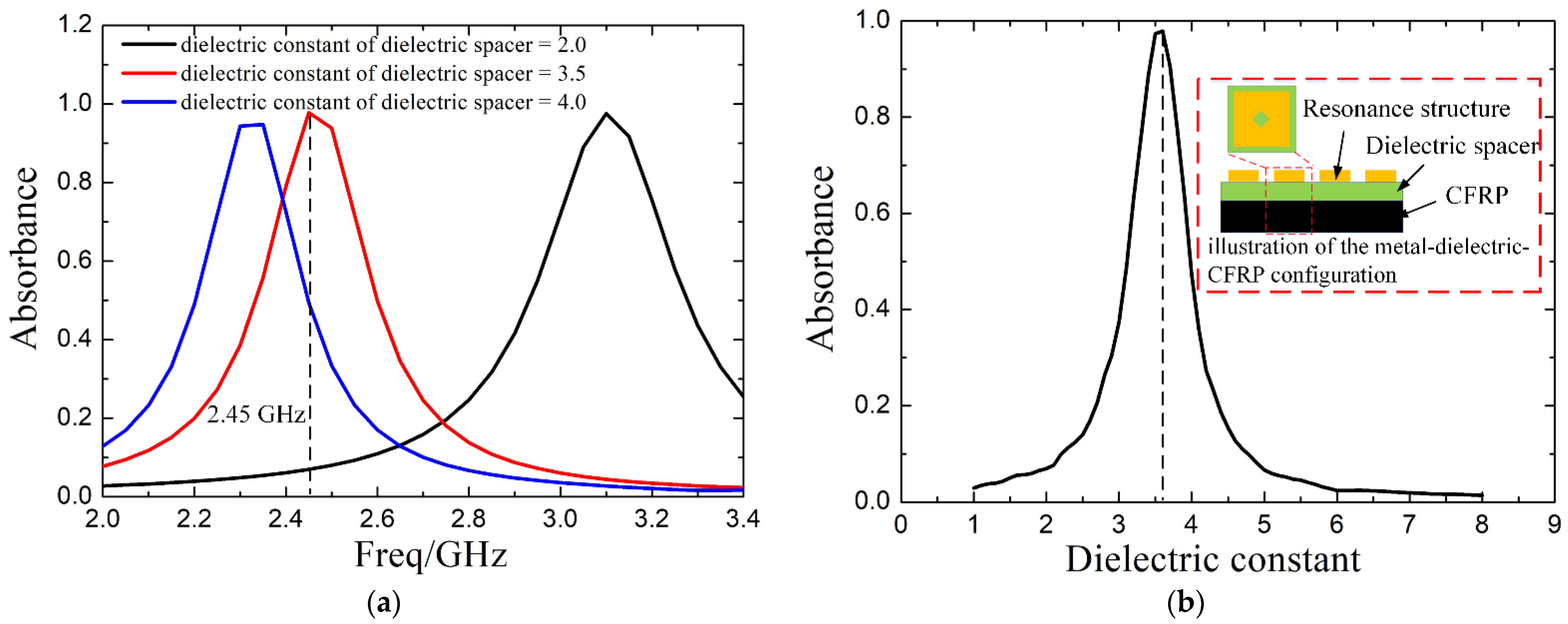

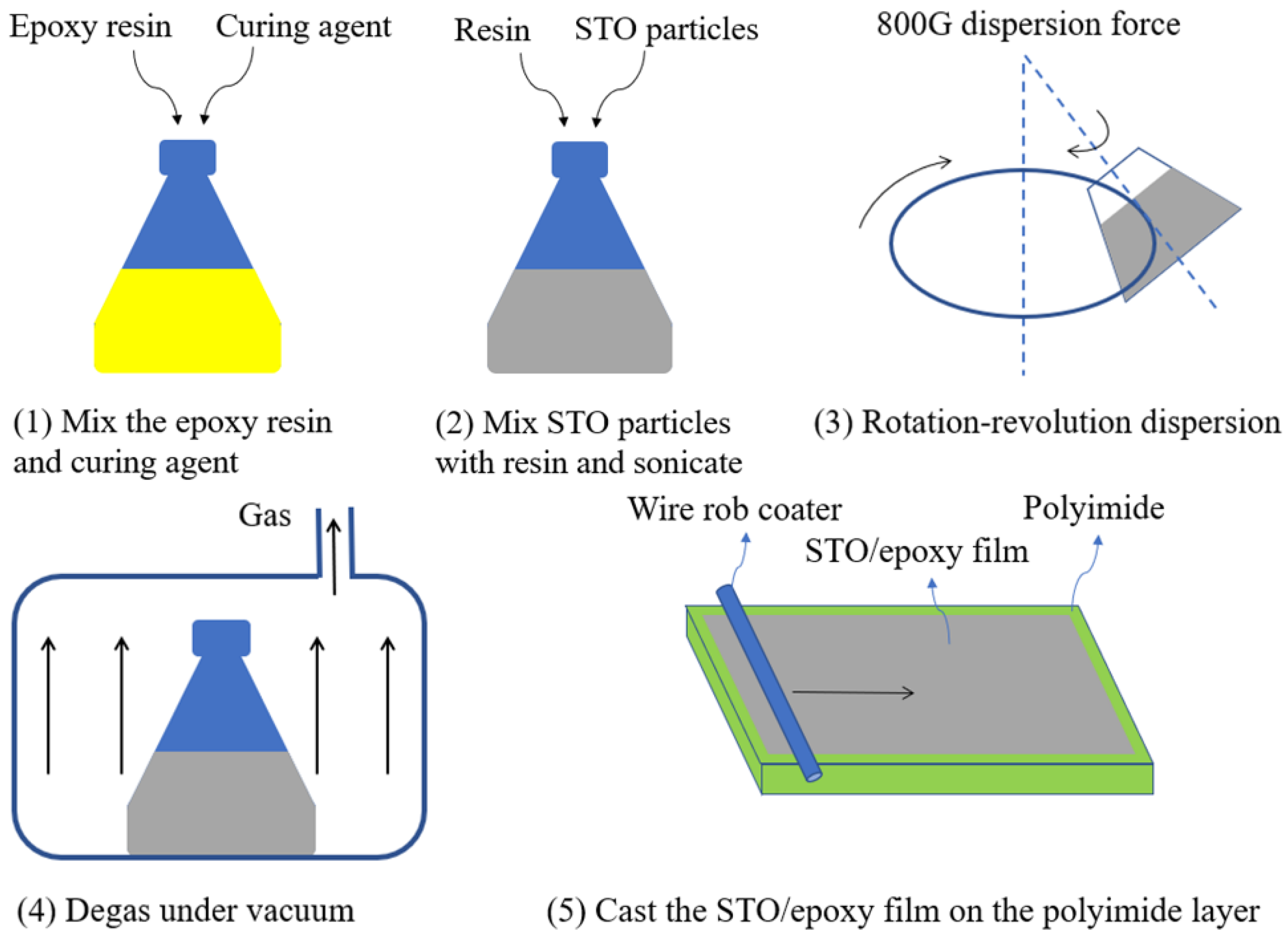
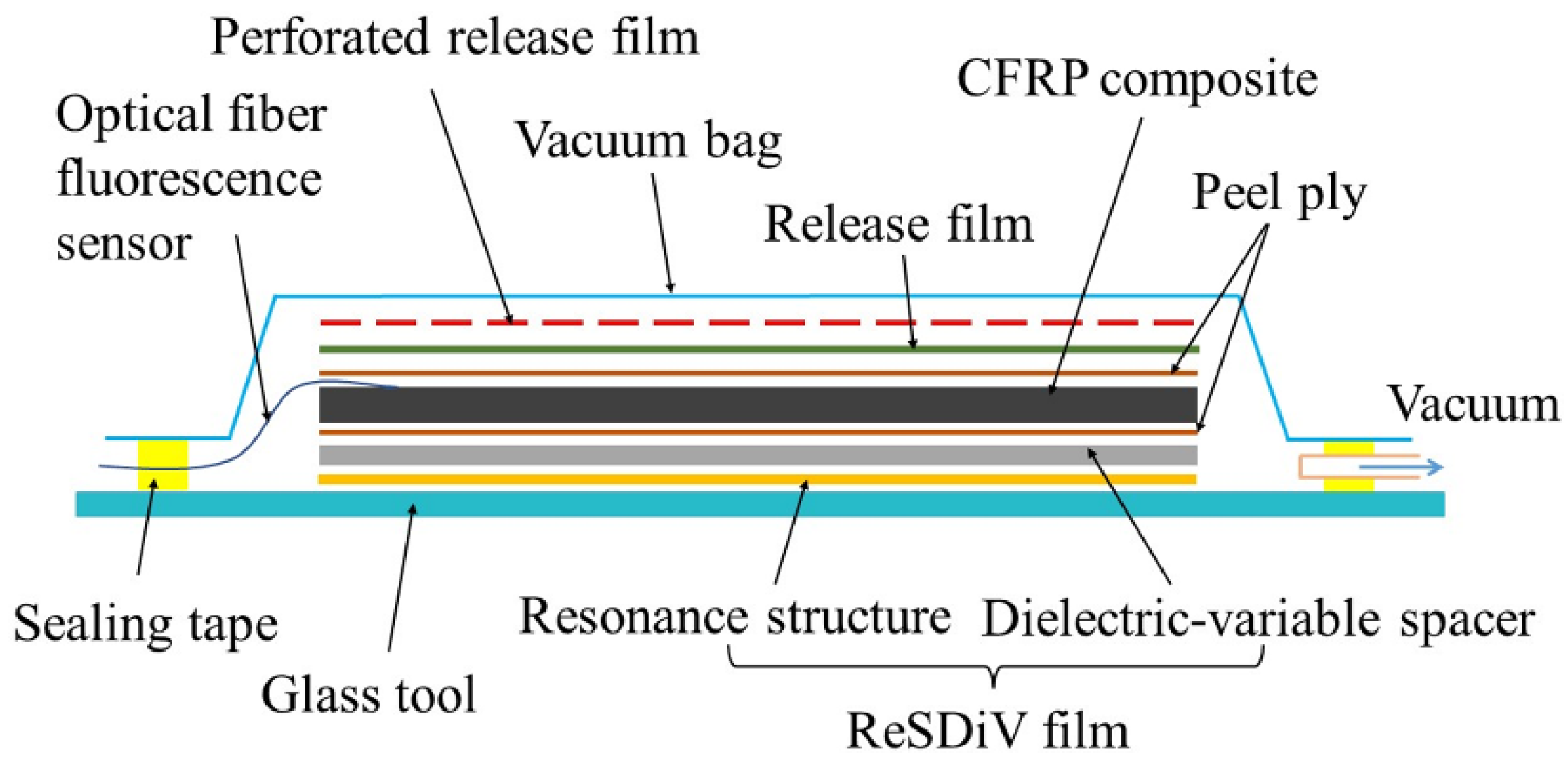
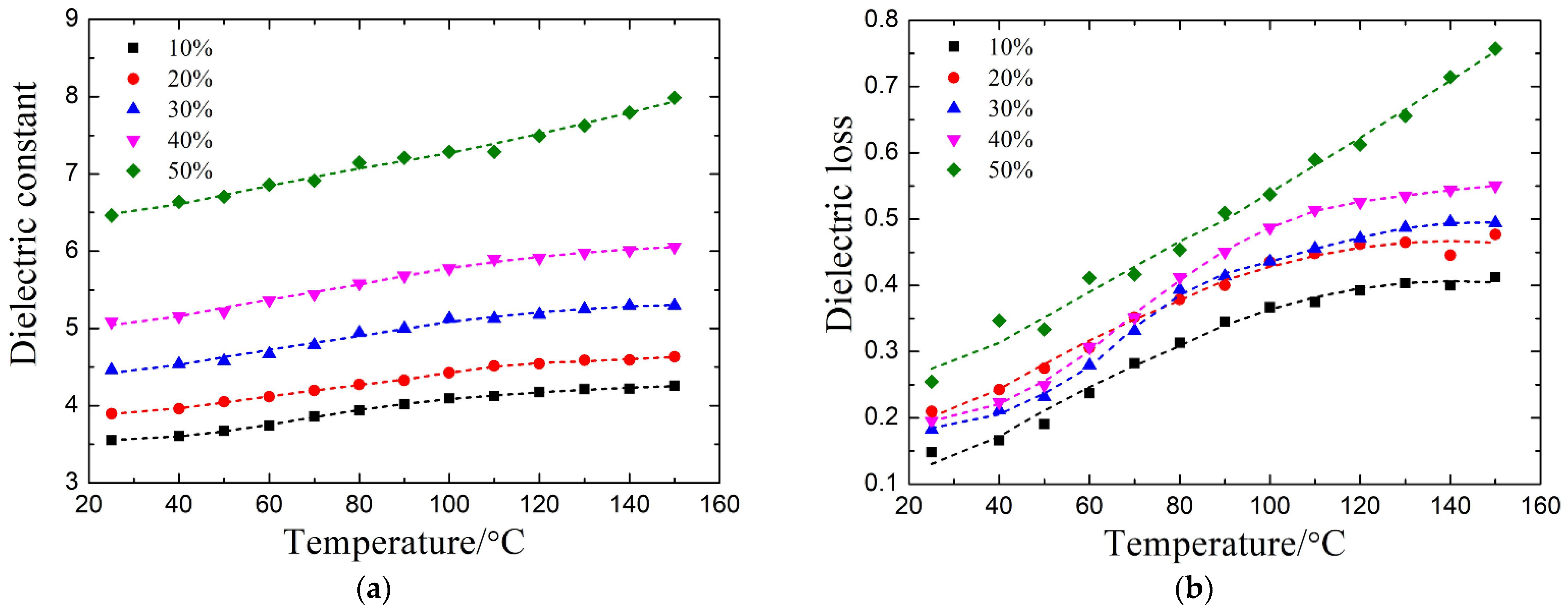



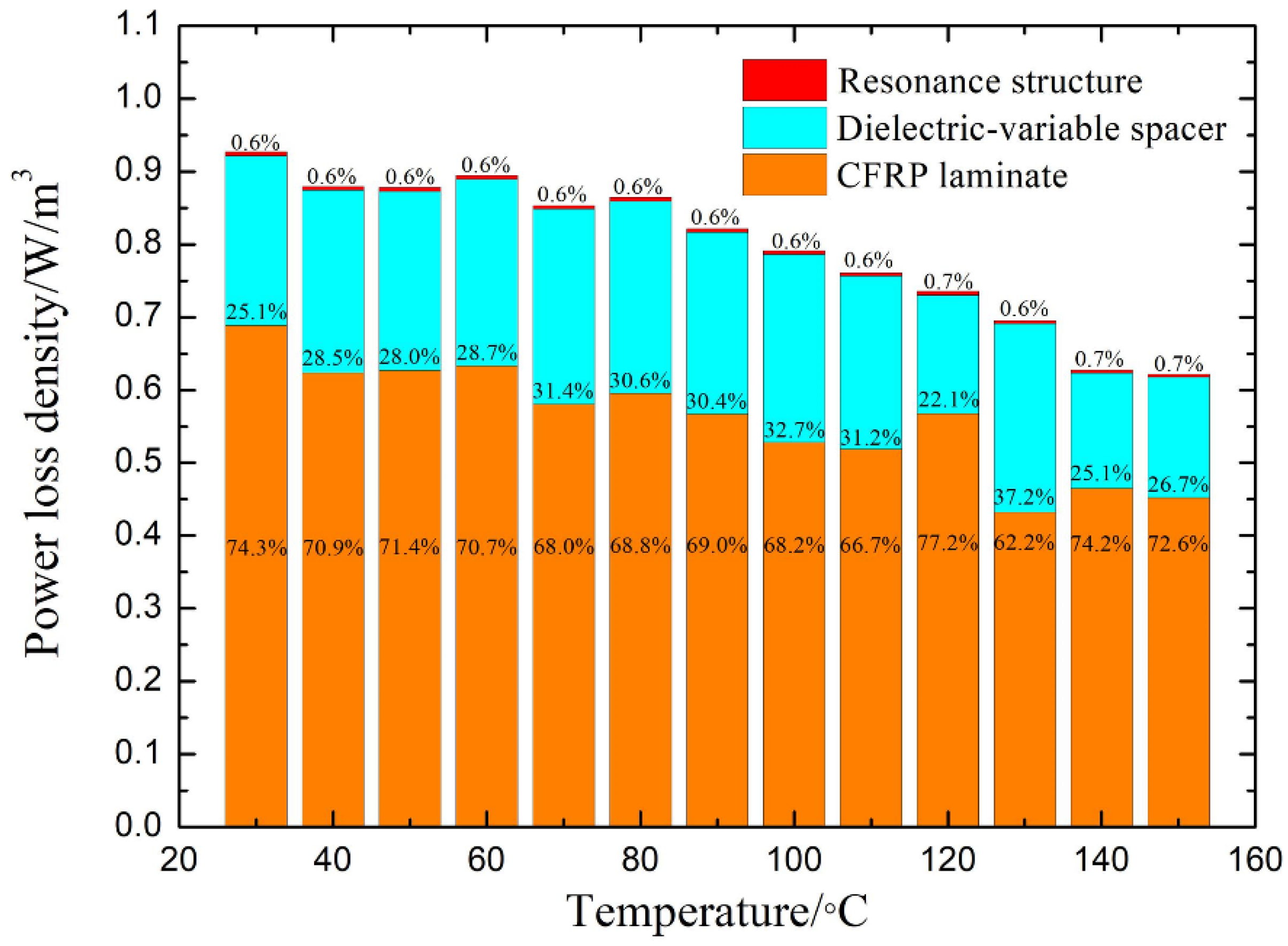
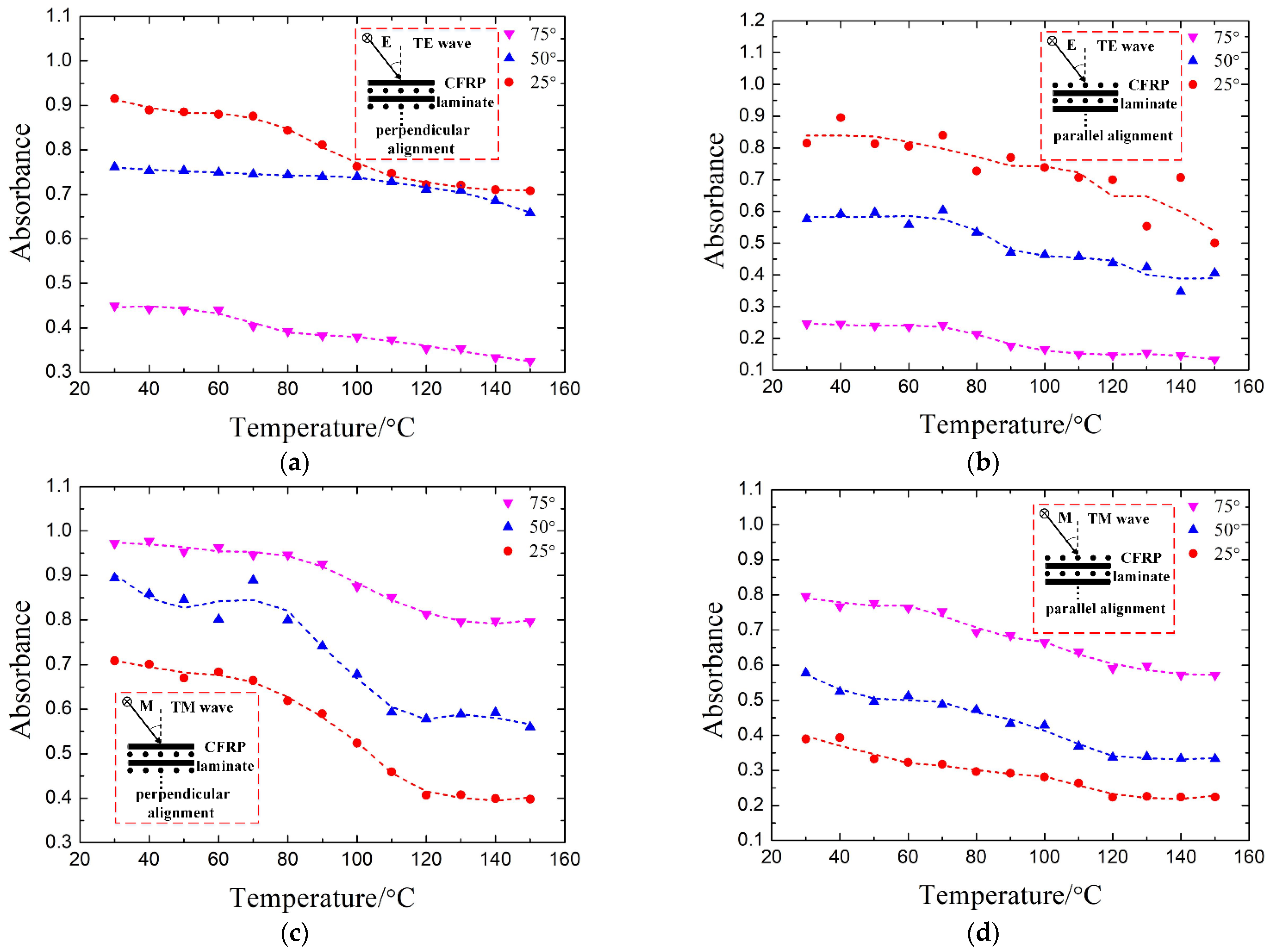
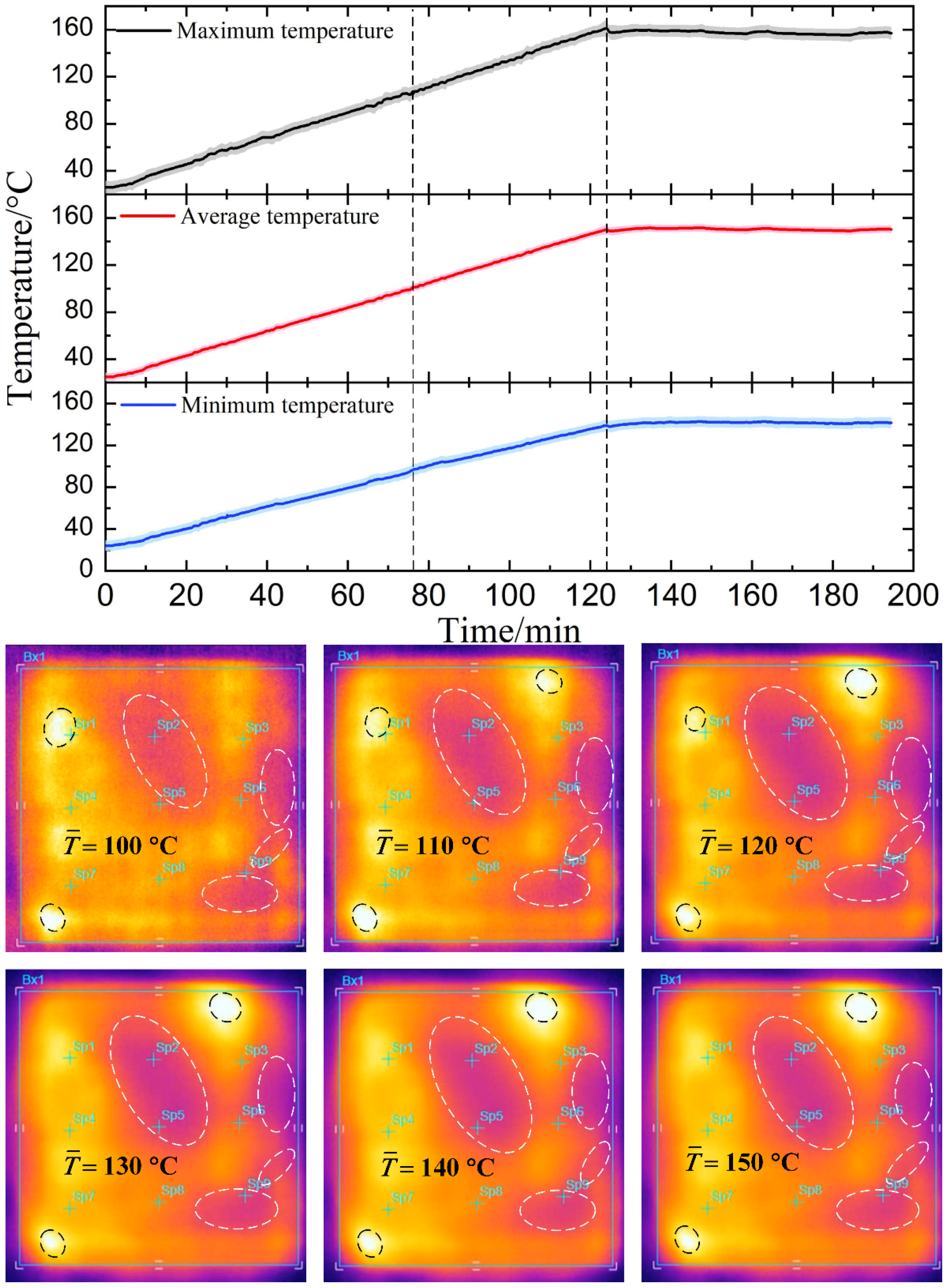
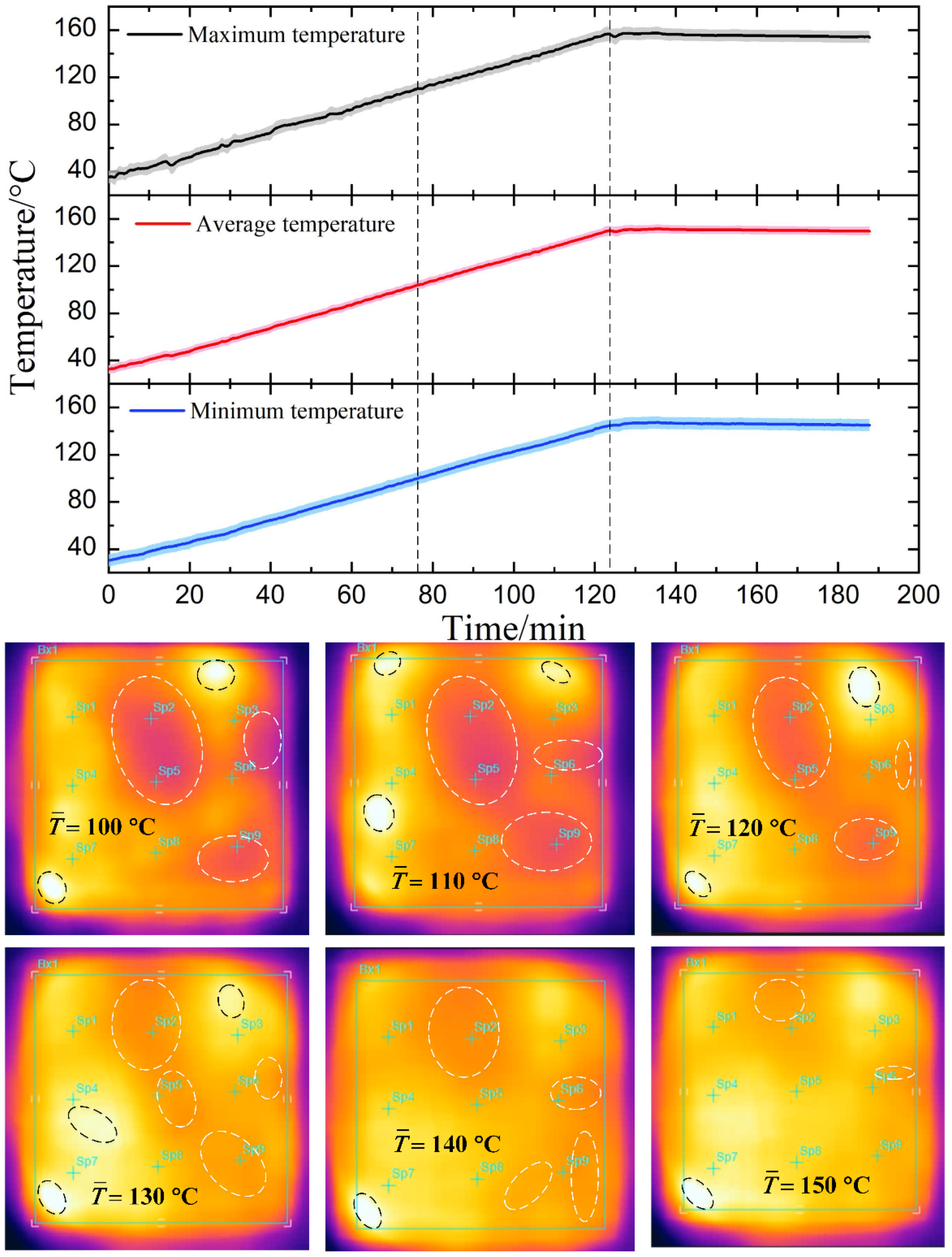
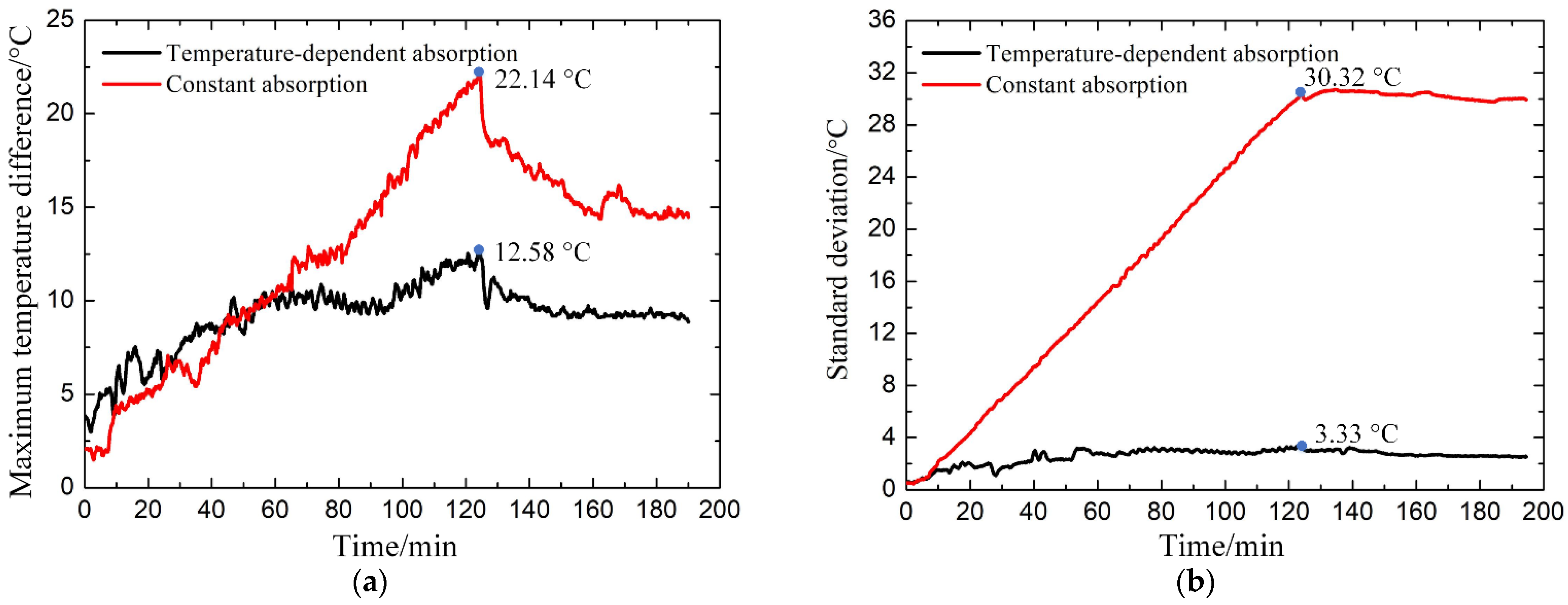
Publisher’s Note: MDPI stays neutral with regard to jurisdictional claims in published maps and institutional affiliations. |
© 2021 by the authors. Licensee MDPI, Basel, Switzerland. This article is an open access article distributed under the terms and conditions of the Creative Commons Attribution (CC BY) license (https://creativecommons.org/licenses/by/4.0/).
Share and Cite
Li, S.; Li, Y.; Zhou, J.; Wen, Y. Improvement of Heating Uniformity by Limiting the Absorption of Hot Areas in Microwave Processing of CFRP Composites. Materials 2021, 14, 7769. https://doi.org/10.3390/ma14247769
Li S, Li Y, Zhou J, Wen Y. Improvement of Heating Uniformity by Limiting the Absorption of Hot Areas in Microwave Processing of CFRP Composites. Materials. 2021; 14(24):7769. https://doi.org/10.3390/ma14247769
Chicago/Turabian StyleLi, Shengping, Yingguang Li, Jing Zhou, and Youyi Wen. 2021. "Improvement of Heating Uniformity by Limiting the Absorption of Hot Areas in Microwave Processing of CFRP Composites" Materials 14, no. 24: 7769. https://doi.org/10.3390/ma14247769





